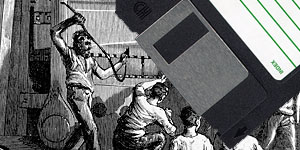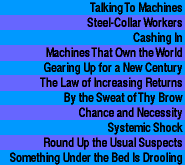


Talking To Machines
If you look closely at whatever you're wearing that's woven, you'll see interwoven horizontal and vertical threads. To weave a pattern on the cloth, say a brocade, someone, once upon a time, had to raise hundreds of specific verticals at a time and pass the current horizontal thread under them and over all the other verticals. Raising even one wrong thread at any time ruined the pattern, and one bolt of cloth could contain hundreds of thousands of threads. For centuries, with human weavers, mistakes were inevitable.Then in 1725, a French weaver named Basile Bouchon thought of a clever way to improve things. Perhaps he got the idea from a carillon---a rotating barrel with metal studs on it to control the ringing of church bells---like the control mechanisms in today's music boxes or player pianos. Bouchon made his loom semiautomatic by using a paper loop with rows of holes punched in it. As he operated the loom, the paper loop would revolve to present different patterns of holes to a row of little rods. Only the rods going through holes could raise their attached threads. He could then pass the shuttle under all those raised threads, completing one more strand of the weave.
So, in a primitive way, Bouchon had found a way to talk to his loom. He could now tell it what he wanted directly, instead of having to use assistants as intermediaries. With just two simple commands, hole and no hole, he had found a way to make his wishes tangible, just as the raised bumps on carillons made intangible sequences of peals tangible. Like a blind man reading Braille, his loom now knew exactly what he wanted done and when.
Bouchon's idea had consequences. For one thing, he didn't need assistants anymore. He had only to keep the loop moving and move the shuttle back and forth under whichever threads rose at each step. To change the pattern, he simply changed the loop. Weaving became faster, cheaper, easier, and almost error free.
You might think that everyone fell over themselves to get one of the new looms. But that isn't how most people work. Weavers' assistants, seeing their livelihoods threatened, destroyed the new looms. Master weavers seeking to protect their monopoly bought all the new looms, while aristocrats and priests, who saw innovation of any kind as a threat to their authority, suppressed the looms. So they all went about their business, assuming things would stay the same forever. Too busy dancing on the growing volcano of social change, they didn't listen to its rumbles.
The new loom gathered dust in the Paris Museum of Arts and Crafts while the French Revolution came and went. Then in 1800, another French weaver named Joseph Jacquard was asked to reassemble it. Adapting an earlier idea, he replaced the paper loop with punch cards. Together with his other changes, that made the loom commercially viable and easy for one person to use. There the matter rested. Despite various grumbles against it, the mechanical loom was widely adopted and made handsome profits for its owners but wasn't significantly improved any further.
Which is too bad, really. Because out of the mechanical loom eventually came the earliest computers. If weavers had gone on to develop the computer instead of waiting for mathematicians and engineers to do it, computers might first have been seen as graphics machines and pattern weavers instead of number crunchers. Perhaps people in the arts and humanities would have worked with them much sooner, instead of thinking of them as soulless machines useful only for calculating incomprehensible mathematics. Perhaps.